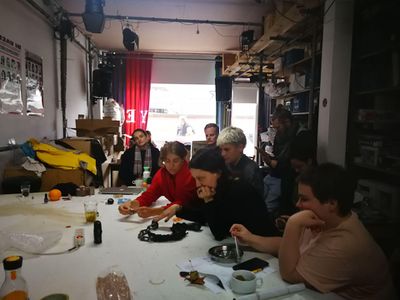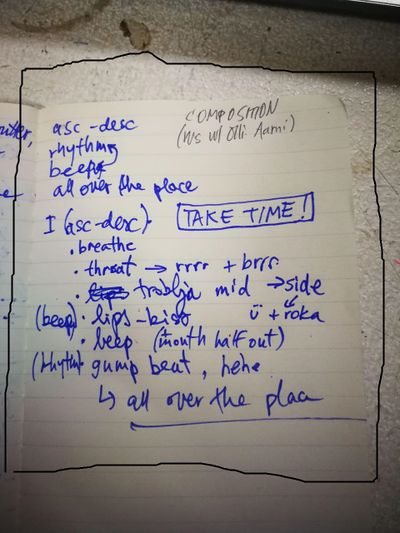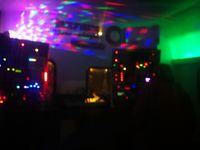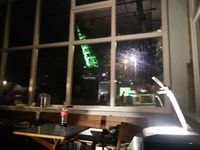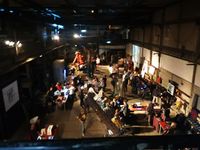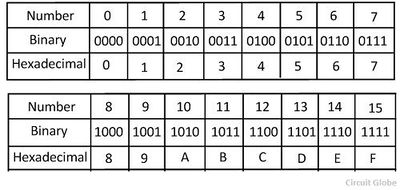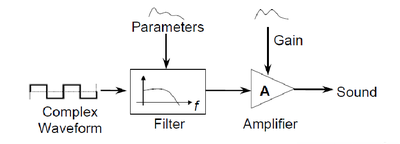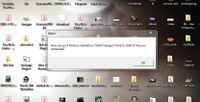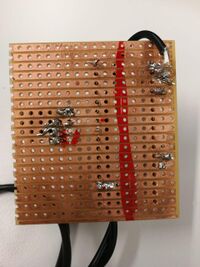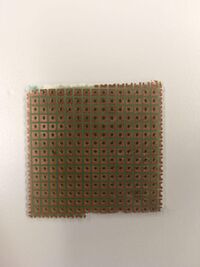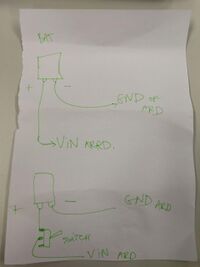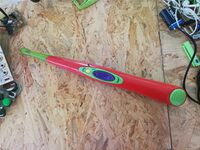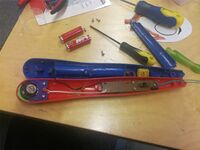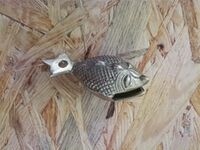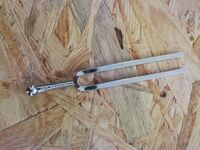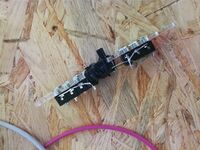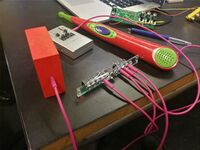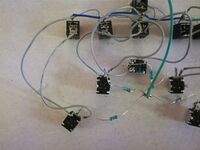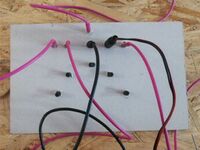User:Tisa/special issue 10: Difference between revisions
No edit summary |
|||
| Line 438: | Line 438: | ||
*to continue with the code. Find out how to connect the sound to the time delay, to make the sound last a certain time. | *to continue with the code. Find out how to connect the sound to the time delay, to make the sound last a certain time. | ||
*think about the wearability of it, its final form. | *think about the wearability of it, its final form. | ||
*think about also modulating the sound (Andre suggests). Maybe having a random value on a library of 30 different notification sounds. Randomly assigned or dependant on the purpose of the notification (if connected to a specific function). | |||
*draw maps/thoughts/protocols of this device. | |||
==The master== | ==The master== | ||
Revision as of 12:46, 11 November 2019
Session #1 (17-9-2019)
Thinking ahead: Possibilities of the project:
- different aspects: synthesizer itself, the cover - thus interface, connectivity to the other modules - interrelationality
- software, hardware and the usage -> in practice and in thought.
- connecting modules augments the possibilites - modularity = great affordance
Session #2
Workshop with Olli Aarni (de player, Rotterdam, NL | 23&24&25-9-2019)
FIRST DAY (23-9-2019)
https://pad.xpub.nl/p/olliworkshop
My thoughts: The difficulties of describing sound. (Remember, the workshop w/Dré? -> meta) What are the parameters? VOCABULARY? How poetic can/could/should one be? Imagination when re-constructing a sound from language. Mind modulation.
Limitations, frameworks can be -> are beautiful. For example the 5 strings on the finish Kantele or the Etiopian Begena. How can the "vocabulary" expand, from simple words to complex sentences.
Exercise: Fictional designs, interfaces for the principle of string instruments. For example a harp in a tall staircase, strings being fixed on top and the bottom, played while ascending-descending. A giant that plays the bridge.
Buzzing against mosquitoes. Buzzing against young people.
Active listening - Pauline Oliveros
When listening - isolating sources of sound from one another. Specific - general sound. Being aware of the sound that we are producing? Hamburg trainstation - soundscape.
Negative-positive-neutral sound perception?
Snow playing on citre. or rain Drops of water in a cave. [ https://naturebliss.bandcamp.com/album/ochiruchirumichiru-kk034 beautifully randomised] Birds playing on guitars. Celeste Boursier-Mougenot
Randomness (lava lamp) generator.
Interfaces of language: spoken | symbolic | written
Where is the limit between language and music? Language and poetry?
What are the relevant questions here?
Pesniške figure -> research more.
Exercise: Describe a sound (from a 20-minute walk around the block), without referencing to its source.
Sound walks.
"Shortly continuous, a swipe, a one time non-repeatable gesture, soft, mid + high spectrum, (a surprise under the feet), a memory of a complex unisono, in silence loudly perceived." -> krhkojemajoč, a leaf cracking under feet.
"Round and metalic, not intentional, broken in two repetitions, the second one prolonged, louder than the space around, when you flinch, loose control, a disruption." tonorijska zdrznitev, a spoon falling somewhere.
Listened to the beautiful Eliane Radigue: Feedback works (1969–1970): feedback with microphones, speakers and reel-to-reel tape machines Adnos III (1979–1980): arp2500 Occam Ocean II (2015): orchestra, oral instructions ->
// a whale on the edge almost crashing down in between skyscrapers, a swarm of wasps approaching from afar .. The extended moment of waiting, refusing to know the outcome that sometimes reveals we do not at all have control. Nauseous morning of stillness. States on the verge of admiration. Simplicities shifting between complex layers //
SECOND DAY (24-9-2019)
Overview of "some" sound terms.
I'm getting somehow annoyed, or shall I say stimulated by the nature of our debates. It's this silence that is painful for a full mind. The discrepancy between thinking and saying. I thought that in this environment people would be inspired and empowered to speak their mind, to invent thoughts and concepts as we go. (Is fear, self-image here the preventing factor?) Preconceived knowledge or ideas here as not as important as is the real-time process, an open collective workflow. Nobody has to apologize for the lack of their knowledge, come on. I guess I was mistaking and I'm going to be (again) in this ungrateful position of always having to say something but holding myself back in order not to override this (unproductive) group dynamic. I'm being cruel here. But this situation in itself is cruel to me.
Highlights:
Needing a reference to describe a sound - a question of approach and the logic of perception: do we want to speak about sound in a poetic or scientific way? In what way for what purpose? It is almost a question of metaphors
Exercise 1: 1) Listen to the sound & name the file with one word (attach it to the original name). 2) Listen to the sounds, try to find connections between them, link them together in folders (at least 3 categories), name the folders so that they describe their content. 3) Create a text file in a folder where you explain why they are similar/grouped together.
Exercise 2: Listen to the soundfiles and place them in categories you've created during the previous exercise. If they don't fit different categories perfectly, find one that's closest. You can place the sounds in the category folders or attach the names of the categories to their filenames. -> funny, most of them just fit into the category named "all around the place" - is it noise, or what?!
How would it be possible to make an overview, a statistic of the overlapping categories of all of us (very different approaches, mostly not connected to the definitions of words related to sound that we have started defining in the morning)? -> WORDS on the pad #todo construct a stable dictionary.
And again this question appears - in what way to describe? Ficitional, story-like, imaginative or generally valid PARAMETERS, theoretical. Is it a question of basic knowledge, vocabulary? Intent of the writing? How would you write an article/a report from a concert, a poem, a text msg for a friend, naming a sound file? So, is it intended to clearly represent the parameters or to augment the hearable? Who can hear it, who doesn't (along with reading). It's a question of abstract or concrete worlds colliding? Where is this line between the birocratic and the poetic language? They are always OVERLAPPING. How to handle this while trying to combine them into a system, a cathegorisation?
Metaphorically I can think of this matter by the analogy of a lightning bolt. Imagine, it strucks a tree, a primal human observing it catching fire. He finds the explanation of it in the abstract, imaginatory, a diety, a god is created, blamed for the magnificent phenomenon of fire. Moving up on the slider of time, humanity is faced with science. And then at some point we have Tesla that begins to understand the lightning and use it in other ways. The god here is just a memory of the mysteriousness. - - - Where are we, right now, on this time slider? Do we satisfy ourselves with the existence of god and mystery, or do we make an effort to step out of the comfort zones of divine abstraction, imagination and synchronize with contemporaneity that possesses scientifically proven and discovered phenomenon?
Or a better direction of this thought is - how to combine the two - in order to understand reality. Here, I am speaking about a similar binary as the rational:sensory. Again this question of the relation between poetry and theory. How to think, to speak, to write about occurences? It is not a question of choosing in between the two "protocols". It is a question of HOW to approach the matter all together. Perhaps letting yourself (exit) transform the realm of the academic and confront concepts differently. #todo + add different possible exercises in writing/thought -> approaches and positions, merging them into a fluid construction. Knowing different tools (like sounds of one object), playing with its possibilities, through experimentation, trial&error. Selectively using this set of tools in order to produce a certain effect, to address individuals - who?.
knowledge+intuition. overthinking?
THIRD DAY (25-9-2019)
define cacophony: A harsh discordant mixture of sounds.
Making a playlist - each one of us, sharing what the core of sound is. Also the sound works/pieces that we've done.
Peter was expaining - Tetragamacilculaire by De Player, a publication without a strict format. "the anti record" Check out the previous publication TGC #3 here.
Check out: Nam Jun Paik #todo
Exercise - find various sounds from the objects brought: short, quiet, long, texturalised, The ping pong ball is the meta example for all the phenomenon of sound.
- ASMR, foley.
- Antwerp radio centraal
- Which rapper said that music is the way we decorate time/make time beautiful? It was not a rapper, it was Jean-Michel Basquiat: "Art is how we decorate space; music is how we decorate time."
Exercise - use the categories from yesterday as an inspiration, make a score for the objects, sketch the sound, write down a notation, perform it. The composition:
The recording:
ABOUT LANGUAGE: letters vs. phonemes (different sound) -> "minimal pair" also: toneme (different tone, melody of a word), chroneme (different duration).
Differences between spoken and written language. Oral literature (improvisation, ever-changing, variation, performed as a song, a melody - access to memory, rephrasing the same content). Finish Kalevala, oral folk poetry
Memory function - memorizing through music, sound, meter. Try it.
Language as well https://www.youtube.com/watch?v=KQ1U3XbEzR4.
(EXTENDED) EXCURSION to DUTCH MODULAR FEST
(@De Besturing, Den Haag, NL | 27&28-9-2019)
After attending the Dutch modular fest (as a member of the press) I'll construct a mashup reportage of the event (possibly merged with Sonica festival Ljubljana).
The reportage will be aired in the first week of octoberon Radio Student as a RADAR radio show.
Description of RADAR: Open radio (artistic-theoretic) research platform RADAR is meant for broader promotion and presentation as well as a radio or (inter)media upgrade and cocreation of artistic events, projects and initiatives in the field of so called intermedia and performative arts. It is a cooperative platform, open for a manifold of collaborations - with individuals, associations, galleries, institutions, other radio stations etc., with the help of the production and communication infrastructure of Radio Student it supports alternative and innovative usage of the radio medium in artistic or broadly socially and medially critical intentions. Consequently, the show does not have a fixed author nor a stable airing time.
My METHODOLOGY of being there as a reporter, but at the same time a musician, an enthusiast, eager to learn was to INTERVIEW the people involved - the makers, the performers, the observers.
I have beforehand constructed a couple of basic questions (together with Urška Savič, a friend that has been running the radio show for a while):
- Are you a musician?
- Why do you create?
- For whom do you create?
- Every bourgeois family used to have a piano at home. Does each middle class citoyen have a modular now? AKA. For which social class is "noise" meant for?
These questions got deconstructed throughout the interviews, as I was more freely roaming around and actually getting to know the people, the scene and what the appropriate questions to ask were - based on the answers, fields of importance and emphasis.
The topics that culminated from the re-constructed questions: family/community, modulation, thinking modular, sharing, improvisation, failure, future (commercialization). The questions that stayed intact were Why? & For whom do you create?
People that I interviewed:
Martin ?, Konstantin Gervis, Christian Vogel, Kassen Oud, Jan Willem, Harold Verra, Mandy Bakker, Hilde Wollenstein, Gökay Atabek, Jan Caron, Joker Nies, Rob Hordijk, Mariette Groot, Paul Tas.
Why I found the beauty of interviewing?
To be in a role of a reporter, of someone who visits in order to spread it, to spread the experience, to spread the event with others, I almost enter into being an official figure, role, the media. My ticket is free, my beer is fre. People accept me instantaneously. It is a privileged position of entry, a capacity to form connections and especially to ask the questions. Of course, we are as individuals always able to ask others the questions that we wanna know, but the form of the interview kind of creates a possibility of interrogating the meaning, reaching into someones' consciousness and challenging them into deeply explaining their principles while being focused on the theme. Because there is this recorder in front of them and they cannot not see it. It always influences the way the people speak and how articulated they are. For me, it is beautiful also to give myself a chance to actually listen to what somebody has to say, which challenges my thoughts that a lot of times function as a distraction into a meaning that somebody else is creating by speaking. It is a challenge, because I want to interrupt, I want to say my opinion, I want to relate to other people in a way.... So, by giving them space, by putting them in the spotlight, they actually have the ability to be fully concentrated and open by what they are doing. They know that they are not speaking only to me, they are speaking to all of the people that my report will touch. To have a free form as RADAR is magnificent, because you can follow your own interests and through this you can create a non linear narrative of meanings, and reasons, and pursuits. By posing the right questions you can go deeply, by listening deeply you can uncover a little bit of one interesting individual and i like people. So from this perspective to be a journalist, to be a reporter is a possibility of "getting to know". // And when people say "Oh, good question" that means that you've hit the spot of meaning, you have reached the core of their own internal interrogation about the thing that they are doing. With this you challenge them to discover the answer within themselves or to speculate on what this answer could be. Journalism, reporting... I don't know how to call it -> just interviewing peiople is an interface between individual minds and meaning that is transmitting outwards, to the public. It is a tool on how to (with good questions and a lot of listening) unravel the interalities that are screaming to be heard through the art that people are making, but their primary medium is not thought or text or words or meanings, but those are always present in any kind of creation that people do. Therefore, I think that meaning as such, transmitted trough thoughts that become words, language, text or recordings are the necessary acompanyment of any creation. They can be trough the external gaze of someone that is not the creator of the artwork -> that can be criticized, expanded onto meanings that wouldn't be preconceived or thought of by the makers (2:31).
I had difficulties with the genre label to put on "experimental electronic music". Then I was saying "this kind of sound" and people questioned that. What's still up with these labels, disciplines, genres? ...
I had difficulties finding women involved in the scene - I spoke to three. I made the terrible mistake (as I observe now, posteriorily) of asking them the question about women in the scene first, and then follow up with the questions that were meant for everyone (the answers were then strongly connotated by the fist). But I got to know about RE#SISTER and also this database of female artists.
Chosen protocol/strategy for the post-production of interviews (list):
Listen:
1) name, match up with the notebook
2) take notes/annotate
Further:
1) expand ideas and concepts (by text)
2) write people more questions (mail) on mentioned topics
Then:
1) fix temporary protocols/principles/composition techniques
2) return (feed) it into own practice of sound, implement the thought.
Consequentially share everything:
1) recordings of interview (via rš or also else?)
2) writings (Transcripts and developments)
3) own sound pieces/sessions
Lastly:
Produce a discussion (on mail (sent back individually or making a little dmf interviewees list), in the "comment section", live with schoolmates of xpub, or de player or worm or friends or else)
I really need an output, own channel of publication {objavljanje} - a webpage of also all my previous, archived projects, projects in the process of becoming, thoughts and texts, included comments section. For text, sound, video, photo, interviews.... -> make hotglue?! With an intricate, intuitive structure.
Session #3 (1-10-2019)
Arduino IDE (integrated development environment) + hardware (history here)
--> http://pzwiki.wdka.nl/mediadesign/Arduino101
void -> functions that don't have any output. // -> disable a line (ctr+/ -> shortcut) /* */ -> disable a multiple lines serial connection - usb
delay (1000) // pauses a loop for 1000 ms
Loops: for, while, ...
A variable -> stores numbers or text.
("") -> string
int = integer, a number without decimals, a whole number. float = number with decimals- char = it's a character,
while + condition (0 or 1) -> while it's true ...
++ -> +
== -> =
= -> transforms it
&& -> and
|| -> or
All the same: d = d+1, d += 1, d++ -> plus one
Session #4 (8-10-2019)
with Dennis -> https://pad.xpub.nl/p/xpub1temp
Additive synthesis. Combine multiple simple waveforms into complex ones.
Substractive synthesis. Start with complex waveform (noise) and filter (sculpt) away undesired frequencies.
FM Synthesis, Frequency Modulation- modulate one (audio frequency) waveform with another (audio frequency) waveform AM Synthesis, (Amplitude / Volume modulation) modulate the volume of a waveform with another waveform (slow (LFO) or fast (Audio Frequency)) Granular Synthesis - take pieces (grains) of complex waveform and glue them together again (in different positions, lenghts, pitches)(substractive + additive) Wavetable Synthesis - play a waveform stored in a table (Predefined waveform in a lookup table) Pyshical Modeling - using mathematical 'models' to recreate physical sounds (instruments, nature)) https://en.wikipedia.org/wiki/Physical_modelling_synthesis
[see more]
Olli
https://pad.xpub.nl/p/olliworkshop2 https://pad.xpub.nl/p/conceptual
Is conceptual work ever redundant? Or just mis-matched with time?
The dichotomy of mystification : demystification seems a bit out. What happened to the mapping mode? What is the topology of common thought? Is consensus ever possible? In what way to approach the construction of a conceptual common ground? It seems that it all starts with techne. And then, when the things will work, we will find their intention? Only tension now (about the conceptual). I think intention is urgent to have. What do you have to say? Say it in a more abstract way. So that nobody understands, not even yourself anymore. At this point we might all reconsider, demystify this common ground of ours, avoiding the gravity that has been present all the while. If we cannot bring sense to the matter, to the core, to the subject -> then each subject individually? There is no excuse from searching for meaning. There is something that connects us all: It's connectivity. The patches, the wires, the infinite cables.
- I want to make this performance where I wrap myself in cables and talk about connection. Being entangled immensely.
Will it help with the resolution of this gordic knot of lacking conceptual commongrounds? Probably not. To criticise it? Most definately. And let's say that I trust my self this much that I think it could be interesting. There are some more things to say on this behalf . . .
Extra session 30-10-2019
w/Denis https://pad.xpub.nl/p/arduinobasics
Session 5-11-2019
at Varia w/Denis and Peter and Aymeric https://pad.xpub.nl/p/xpub15112019
These are the notes from the feedback session: How to combine my machines (that I don't use cuz they are weird shape and the sound could be different and more aesthetic to me) + using the volume thing to make them connected.
made a sample for my module circuit-bending ws
organic blob silicon shape that would host all of these werid organism and put them together. The box - i like and i dont I want it to be more tactile. Having this weird shape that you can play from all sides, with different knobs and sliders and sensors and also analog stuff, contact mic, a regular mic.
Thinking or an organism. It has 7 parts? I really like these machines, but I don't play them. I would like to make them more "uniformed", but not in the box. To see what the possible connections are. To see why one cannot play together with the others (using mixer 1.0) assumption: it has to do with power supply, voltage. To figure out how they could communicate, to ditch the visual aspect, the visuality that they have now. I'd like to put it aside and make a new frame for them. Blob that only has the interfacing parts visible.
Peter: To make it workable for disabled people, for blind people. You dont need your eyes (your fingers) for it. How could it work without using your regular skills? Aymeric: How to interface with others? Input/outputs (meta answer).The Mergrannen is a part of the blob. It is the connective part of the together-modularity. Dennis: How universal do I want to make it? Because now it is specific for the devices that I have now. What if you make a big mixer that would connect any device, that anyone can use. - Shape-wise it is pretty specific to the devices, connected by a mixer. To play around, to understand circuits better, to see what happens. Aymeric: hardware EQ.
silicone mould -> rough sounds, gentle, jellyfish tactility. Dennis: they all use different power sources. Aymeric: You are actually making the whole group project within this BLOB. pre-wire it and make it connectable to other. Peter: You could also focus on the idea of not having a square box but a more intuitive, tactile construction. How to work without knobs for example (using another thing instead of the classical knob - materials).
1. using mergraanen, inputs from others, using pots as volume controllers and then having one "master button" - when you push it, the sample that is uploaded to the arduino is triggered, it cannot stop playing (until it finishes). It is this kind of an "authoritarian button" that overrides all of the other signals coming into the module. Or there might be also a pot volume next to the button. The sample is eaither a text or white noise, as the one that kind of has all of the sounds present anyways -> and this is sort of funny - an authoritarian knob has no choice, it actually cannot conceptualy override the other signals, as it is partially playing them as well (in the all-sounds-present-in-white-noise manner).
2. an everydaylife device "the distraction manager", it is a wearable. It is based on a time sequence (on one potentiometer). There is a sample knob also that determines the harshnes and the duration of the sound (notification). It is a device that makes us less distracted. It is like a trigger from the environment that triggers the subject, the human. There is a set of questions (that at least I try to ask myself in my daily life): How are you? Are you distracted? Are you well-hydrated? Are you hungry? How is your posture? Do you have to go to the toilet? Is it time to stretch? The notification sound is meant to remind one of their own specific questions. A reminder of EXISTENCE. A distraction controller. A machine to interface with yourself.
Session 6-11-2019
with Michael reading this beautiful text #todo annotate also #todo add pictures of the process and scans of the notes.
Prototyping 11-11-2019
with Andre
modules
(25-9-2019) When trying to upload my "ican" sound sample taken from this track the Arduino board and the Arduino nano ran on the linux do not communicate properly.
After one burned board (by the accidentally distructive code from Dennis - she counts, gets too fast, disrupts the flow of information), then miraculously (another machine, another arduino) the sample gets uploaded. It sounds pretty jolly. Annoying after further tryouts at home.
(1-10-2019) with Dennis. Managed to upload a new sample. The samplify (in utils directory/folder) script didn't work on my cygwin, that's why I opened it up in a text editor and manually ran each line of code. It worked!
Then we made the arduino code blinky_1-10-2019 from 0 to 5V. to trigger another module with it.
(2-10-2019) with Michael. Different types of signals: control signal ((for example the blinky code) high, low) , audio signal ???
Serial plotter: File:Serial plotter.mp4
Ask Aymeric and Andre for PD applications - possible connections with the modules. mail: Yesterday I got an impulse to start thinking about possible connections between our modules (Arduino) and PureData. Michael called upon you two as experts on the matter. Would it be possible to have a pd crash course? ( I only worked with Max a bit before) Or a coffee conversation on where it could go (conceptually, tech-wise)?
response: Good connection, there's an actual historical link between modular synths and Pd in the context of the evolution of electroacoustic music technologies. However it's important to stay focus on the meergranen board for now, time is flying and better concentrate energies on one system, specially if it is a challenging one. For tomorrow Dennis is preparing some simple basic module code so it becomes easier to connect the dots and the boards. Later in the year, if there's enough interest for a small Pd workshop, beginners or advanced, I'd be very happy to give it to those interested, but for now I think it could be a risky sidetracking.
(6-11-2019) #todo write down ideas for my modules + add pictures.
Tisa Name of module / Audio/visual/other: audio, textuality Input: audio from elsewhere - but you really don't need it. there is a button you push that triggers the rec Output: audio recording of a text Description/Algorithm:has to be thought trough in terms of concept-contextuality. It is about conveying information (reading a text that I'd like people to hear), conceptualized "trigger". Once you press the button, it triggers a recording and simultaneously over-rides, significantly diminishes all the other signals (making them a background or completely silent?). Once played, the recording cannot be stopped, from this perspective it is an authoritarian audio mixer.
Distraction manager
Trigger for humans & the surroundings. "It distracts you from being distracted."
It is a device that makes us less distracted. It is like a trigger from the environment that triggers the subject, the human.
It is a device that is constructed to optimize the relation between time and activity. Especially in relation to distraction. write more #todo It is a wearable "notification" generator, based on the time sequence from 5 minutes to 60 minutes. After this time, there is a sound, resembling a notification. It notifies you of your distraction. A machine functions as a trigger for the individual, the subject, the human. It triggers good habits and keep track of - focus, state, activity ...
There is a set of questions (that at least I try to ask myself in my daily life): How are you? Are you distracted? Are you well-hydrated? Are you hungry? How is your posture? Do you have to go to the toilet? Is it time to stretch? The notification sound is meant to remind the one using the machine of their own specific questions. A reminder of EXISTENCE. A distraction manager. A machine to interface with yourself.
It consists of one potentiometer (that determines the sound sequence), a power supply (battery), a speaker and an on-off switch.
(6-11-2019) I made a breadboard prototype (with the help of this) And also constructed the basic Arduino code for it -> using the map function on two potentiometers. One controls the 3 possible sound options (using tone or melody or smth else? There is a list of Arduino library extentions - on the pad). The other potentiometer controls the time that passes in between the sound.
There is an option to make this module connectable as an input device for other modules, in a way that a speaker is exchanged for an audio input. But for the sake of the concept it must also stand as an autonomous unit, a wearable device.
(8-11-2019) I have soldered a circuit based on my breadboard tryout. I decided to leave out one potentiometer, the one that would control the sound. Because at this moment, as I conceptually like it, the "notification" sound always is the same for the same thing.
And then: I killed my Arduino Nano.
(11-11-2019) I went to Joana at the Interaction station to see what actually went wrong. We found that the main reason was the pcb that had this linear connections (I never knew that pcb's differ from one another, so here is something that I've learned). And also my soldering was a mess. So, the Nano actually died, because I (the pcb) connected everything, all together. No wonder.
The next steps:
- to re-solder everything on a "normal" pcb.
- to figure out possible external power supply (battery, on pin 30, VIN) - something lighter than the current powerbank. add an on-off switch.
- to continue with the code. Find out how to connect the sound to the time delay, to make the sound last a certain time.
- think about the wearability of it, its final form.
- think about also modulating the sound (Andre suggests). Maybe having a random value on a library of 30 different notification sounds. Randomly assigned or dependant on the purpose of the notification (if connected to a specific function).
- draw maps/thoughts/protocols of this device.
The master
Using mergraanen, inputs from others, using pots as volume controllers and then having one "master button" - when you push it, the sample that is uploaded to the arduino is triggered, it cannot stop playing (until it finishes).
It is this kind of an "authoritarian button" that overrides all of the other signals coming into the module. Or there might be also a pot volume next to the button? The sample is either a text or white noise, as the one that kind of has all of the sounds present anyways -> and this is sort of funny - an authoritarian knob has no choice, it actually cannot conceptually override the other signals, as it is partially playing them as well (in the all-sounds-present-in-white-noise manner).
Hardware
Bought a 2,5€ microphone with a mini jack in Action, but apparently it doesn't work. I will probably disassemble it, see what's inside, if anything at all. Maybe just a sheel, a sad shell without any sound in it, not even the waves.
The 4-legged machine only has two legs - potentiometers -> fixed it.
My noise machines are not really compatible with the module, only the bug is (but it's very high pitched and I don't like it.)
The aesthetics of sound: I want to have some machine that would make granular sound-wall, white noise-
The interaction: The plan is to make my performances more real-time, more based on improvisation, echoing all the knowledge about it that I have acquired in the past few years (through theater, playing instruments, vocal improvisation, free-writing etc.)
Overview of the machines
super-in-low
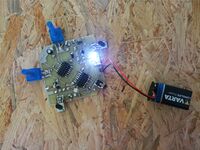 Made by Theremidi orchestra, built by me here
Made by Theremidi orchestra, built by me here
motheremin
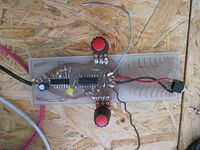 Made by Staša Guček, a part of ČIPke initiative, built by me.
Made by Staša Guček, a part of ČIPke initiative, built by me.
alien
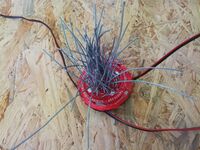 Made by me on PIFcamp 2018.
Made by me on PIFcamp 2018.
svarog3
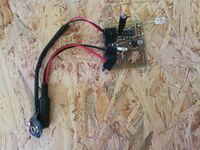 Made by Monika Pocrnjić, built by me here
Made by Monika Pocrnjić, built by me here
love-tape
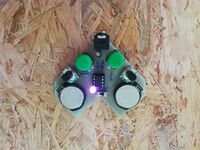 Gotten as a gift from Urška Savič.
Gotten as a gift from Urška Savič.
baby-drummer
pencil
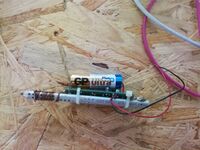 Made by some electrotechnical association in Ljubljana. #todo find documentation.
Made by some electrotechnical association in Ljubljana. #todo find documentation.
fish
fork
kliker
waiting for it, package from Ljubljana. Made by ::vtol::, built by me here.
mixers
mixer 1.0
passive matrix mixer 2.0
I have constructed a "passive audio mixer" from this instruction, a bit tweaked to fit the mono-jack, so - simplified.
amplifier
Also got this from Dennis, could try it out. (But actually what will be more useful is an amplifier for a contact microphone (part of the blob, more analog sounds).): One-transistor audio amplifier for Arduino projects Just tested this and works for amplifing speakers >> (Note: might sound terrible, Note 2: in the schematic the ground of the speaker is drawn over the positive, these are ofcourse not touching, just weirdly drawn)
The BLOB
The blob exists with the function of combining my noise machines and making them finally useful. I don't use them now, because they are shaped weirdly and the sound could also be different, more aesthetic to me.
Thinking or an organism.
An organic blob shape that would host all of these machines. In contrast to a box, a classical way of putting modules together. More tactile.
Having this weird shape that you can play from all sides, with different knobs and sliders and sensors and also analog stuff, contact mic, a regular mic.
Why? To see what the possible connections between machines are.
To see why one cannot play together with the others (using mixer 1.0) assumption: it has to do with power supply, voltage. To figure out how they could communicate, to ditch the visual aspect, the visuality that they have now. I'd like to put it aside and make a new frame for them. Blob that only has the interfacing parts visible.
--- It is a seemingly organic structure, an organism, a host body for my separate noise machines, connecting them into an intuitive system. Oddly looking interface, tactility and unpredictability are its key aspects.
Materials: some sort of plastic. preferably recycled from plastic bags ref
Are there facilities for that at wdka?
Disassembling all of the machines, making it possible for them to fit in with the idea of having knobs and sensors on the surface of the blob.
Plan precisely!
How to power them elegantly (differences in voltages they run on).
Some sort of a mixer is needed to be able to control the presence of separate machines (a specific sound) in final output of the sound. A mixer on the surface. There must be therefore a mapping, an intuitive structure where it is visible to which machine certain knobs belong to.
power supply -> machine (body inside the blob, knobs etc. on the surface) -> mixer - volume knobs (on the surface of the blob, like a control panel) -> master audio output + volume knob.
+additional stuff like:
- a diy fuzz effect
- amplifier of contact microphones
These are the comments from the feedback session (5-11-2019) at Varia:
Peter: To make it workable for disabled people, for blind people. You dont need your eyes (your fingers) for it. How could it work without using your regular skills? Aymeric: How to interface with others? Input/outputs (meta answer).The Mergrannen is a part of the blob. It is the connective part of the together-modularity. Dennis: How universal do I want to make it? Because now it is specific for the devices that I have now. What if you make a big mixer that would connect any device, that anyone can use. - Shape-wise it is pretty specific to the devices, connected by a mixer. To play around, to understand circuits better, to see what happens. Aymeric: hardware EQ.
silicone mould -> rough sounds, gentle, jellyfish tactility. Dennis: they all use different power sources. Aymeric: You are actually making the whole group project within this BLOB. pre-wire it and make it connectable to other. Peter: You could also focus on the idea of not having a square box but a more intuitive, tactile construction. How to work without knobs for example (using another thing instead of the classical knob - materials).
Other, attended
RE#SISTER
6-10-2019 at Worm sound studio.
RADIO SESSION
11-10-2019, 1-3 am, Radio Tonka, den Haag I was invited to the Club Res radio show at Radio Tonka, hosted by Kassen Oud (whom I have met and interviewed at Dutch modular fest) and Rob Bothof. I interviewed them about their show (meta moment) and then we had an improvised session live on air. add #todo report & audio recordings (edited?)
JANDEK (US) + KA BAIRD (US)
17-10-2019, Worm
Attended the concert of long-loved Jandek, discovered the beautifully inspiring Ka Baird.
COMPONENTS
23-10-2019, Varia, Rotterdam a day session of arranging electronic components and cleaning. add #todo photos
NOISE TRANSMISSION DEVICE WORKSHOP
23-10-2019, Worm, Rotterdam A noise transmission device workshop led by Francesco Zedde. Learned how to circuit-bend, by modulating an old radio receiver. + #todo add notes
FLOPPY TOTAAL
19-10-2019, Varia, Rotterdam funny floppy event
Pink (Japa)noise
20-10-2019 Worm, Rotterdam Kurumi Kadoya + Boterklontje write down observations of energy play in the trio.
Performing Obrazi
25-10-2019 Lust, Groningen w/Mojca Zupančič on drums, Filippo Temperini on bas guitar, effects and ableton, Tisa Neža Herlec on voice; Quentin Zero aka Michiel Teeuw and Livia Ribichini on analog visuals (light play)
pad, transcription of composition available here and #todo add the sound recording of the thursday after rehearsal and the performance.
Galeru
26-10-2019 Atelier Il sole in cantina, Groningen https://www.facebook.com/events/1055224001536322/
ANTENNE
3-10-2019 JAB + Yanik Soland
29-10-2019 Yuko Araki + Vot’ress Woa, Yuko Araki!
5-11-2019 Steve Hauschildt + Clementine Edwards
BRAUBLFF 8
31-10-2019 Volunteered at the event Braublff at de player. Mainly because Katalin Ladik was there, whom I deeply respect and admire, knowing her earlier work (also because of her solo exhibition in Ljubljana. Enjoyed the performance of Lore Lixenberg, having her hair cut while vocalising. add #todo photo
A day in one terabyte of the kilobyte age
1-11-2019 Workshop at IMPAKT festival by Olia Lialina. also #todo add photos, edit notes
+question of regarding tagging (geocities archive) -> how to approach the tagging process, cathegorisation. Not knowing what the relevant fields are(concept, structure, content, navigation, ...). It's an alhorithmical work - but how does relevancy relate? (relevant to the subjective? to the time?to the relation of current? to the historical development?) does interpretation fit in? More contributors makes confusion, exactly because of the subjective interpretation of meanings and specific codes of cognition/knowledge/perspective/focal points. Is conceptual common ground even possible? The uniformation of perception, thought. How do we teach AI? https://www.nytimes.com/2018/11/25/business/china-artificial-intelligence-labeling.html Uniformation of sensibility and perception and interpretation. They need to be fed millions of labelled examples to teach them to “see”. https://medium.com/hivedata/ground-truth-gold-intelligent-data-labeling-and-annotation-632f63d9662f https://medium.com/ai%C2%B3-theory-practice-business/methods-of-data-labeling-in-machine-learning-80a34ece6c8b methodologies of collective data investigation (tagging, cathegorisation, structuralisation)
+the future: interlinked or a self-enclosed system (petri dish effect)? concerning intertextuality, hyperlinks, connectivity. ownership, powerplay, network, 3D shematics. https://rhizome.org/editorial/2017/feb/21/all-you-need-is-link/
https://www.thewikigame.com/group
also this work I encountered at Impakt festival: https://ars.electronica.art/outofthebox/en/amazon/
Klankenbos nocturne
A volunteer trip organized by de player. 2-11-2019, https://www.facebook.com/events/493376414792346/
Making a story workshop
3-11-2019, Making a story workshop by Mylan Hoezen at Roodkapje, Rotterdam.
Neverland cinema
26-9-2019 TALK: Artivism: Creative resistance in the era of extinctions add #todo notes 4-11-2019 𝚆𝚘𝚛𝚔𝚎𝚛𝚜 𝚕𝚎𝚊𝚟𝚒𝚗𝚐 𝚝𝚑𝚎 𝚏𝚊𝚌𝚝𝚘𝚛𝚢 (𝟷𝟿𝟿𝟻) write #todo about the dynamics, how life starts after leaving the job ...
UPCOMING
24H
24h second edition. pad sometime in January 2020.
Composing sensibility workshop
looking for a place Possible:
- blank space, Almondestraat
- Ook huis
- Ubik
- ...
Description: Composing sensibility is a workshop, an exploration of our individual capabilities of perception and a collective construction of tactics for the everyday. Believing that sensibility is the fist step towards understanding the world around us, social relations, occurrences, one should train it, include it into the daily routine and always pay attention to oneself, others and the surrounding context. In the workshop, I will propose a set of exercises (merged from sound and theater improvisation techniques, contemporary dance, meditation; based on movement, voice and text) that one can explore by themselves in any environment, at any time. The final outcome is a revalorisation of senses and their potential. Emphasizing the possibility within each individual to interpret and eventually intervene in the existing state of affairs. Real-time sensibility is the first step, interpretation is the second, intervention the third; all of them nurture the other and construct a fluid composition of everyday practice to be aware, present, critical, empowered, sensible.
0EQ
sound resonantial event in The Black Box, HUL studios, Groningen sometime in January 2020.
Mail: So, this is my written proposition, following up the studio open night last month, getting to know the building a bit, that ignited inspiration. I'd like to ask you to forward it to all the other people around HUL - to be able to come to a sort of an agreement and also to invite everyone for collaboration! I was very much inspired by the basement acoustics, experiencing this metronome installation and also just singing in a bit there. The reverberation is magnificent! So, my proposition would be to make a sound happening in the basement (January 2020), using the reverberation as an advantage (usually not wanted while making sound), a point of departure also for the artists (noisy, ambient, free). I already have some people in mind for the sound part, also to collaborate with some sound event makers from Groningen and Rotterdam (that's where I live now). From the visual perspective I think that light installations and sculptures would be krazy-nice. I imagine it being a cave/womb vibe - kind of odd but cozy at the same time. So, this is briefly everything I have 'till now. Let me know what you think, T.

